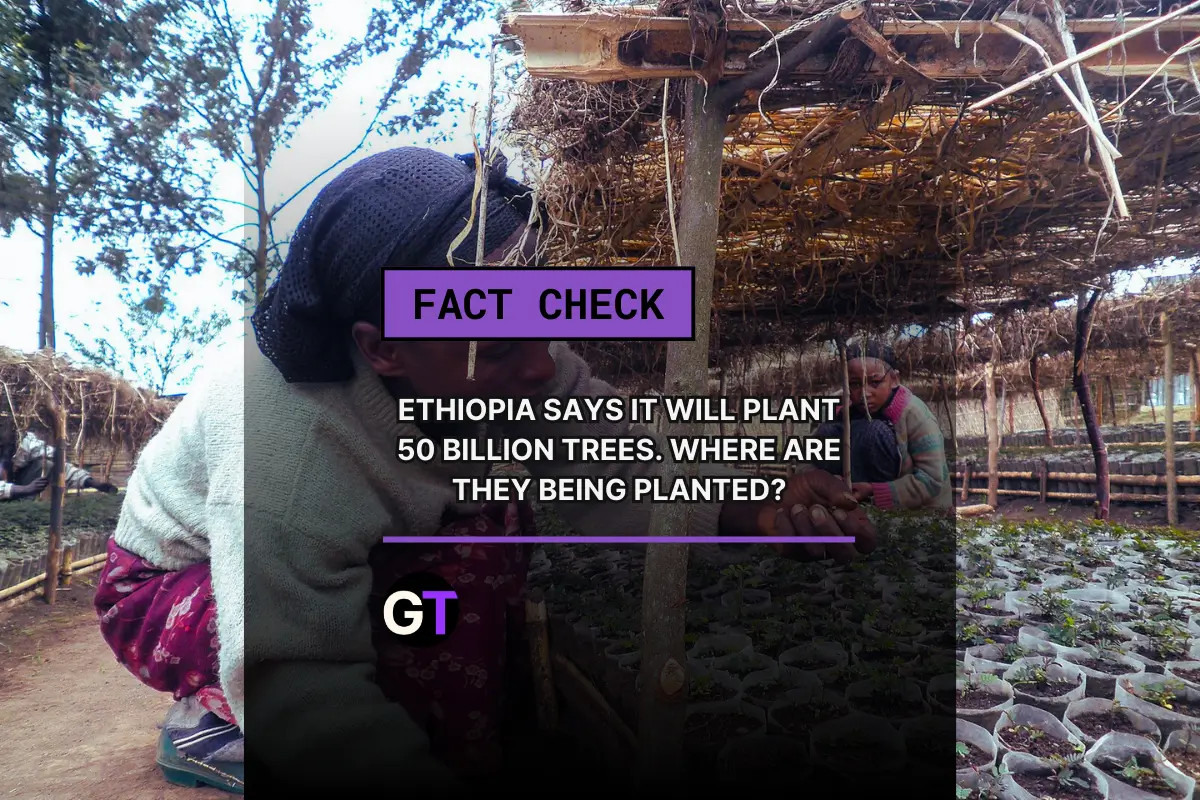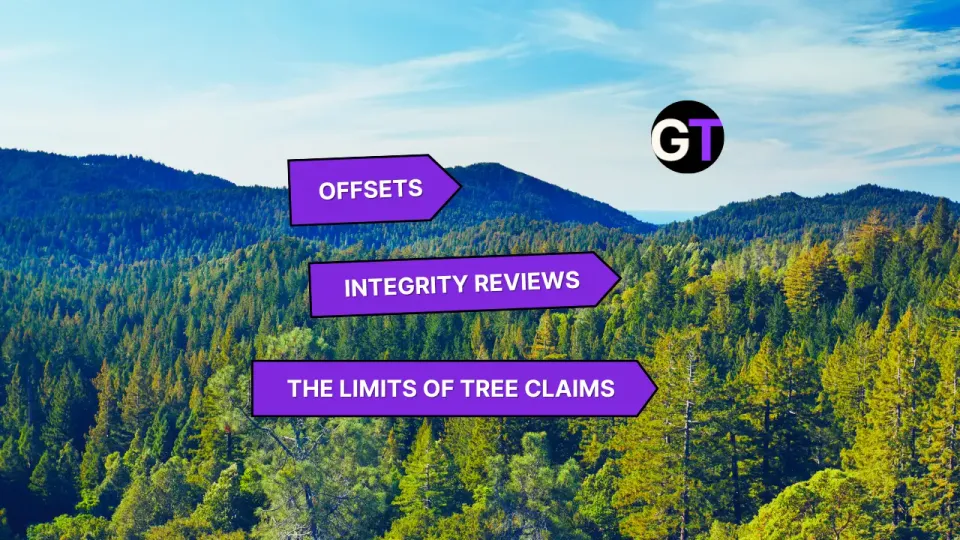Ethiopia's 50 Billion Tree Plan: Hype or Reality?
Ethiopia’s 50B tree plan is ambitious, but experts question numbers, survival rates, and verification. Hype or real impact?

According to the Ethiopian News Agency (ENA), the government claims that Ethiopia is on track to plant 50 billion trees by 2026 as part of its Green Legacy Initiative. If true, this would be one of the largest reforestation efforts in history.
However, conflicting numbers, logistical challenges, and skepticism from experts raise questions about whether this goal is actually achievable. In this fact-check, we break down the numbers, challenges, and reality behind Ethiopia’s ambitious tree-planting campaign.
Is Ethiopia really on track to plant 50 billion trees?
Official Claim: Yes, Ethiopia says it is on track.
Skeptics Say: The numbers don’t add up.
- In 2019, Ethiopia made global headlines by claiming to have planted 350 million trees in a single day, smashing India’s previous record of 50 million. In 2024 they announced 600 million trees in one day. That's the equivalent of all the trees planted in Canada in a year.
- By 2022, officials claimed they had surpassed their 20-billion-tree goal.
- In 2023, Prime Minister Abiy Ahmed upped the ante, declaring that Ethiopia was on track for 50 billion trees—though the Minister of Agriculture’s numbers suggest it’s more like 20–30 billion.
The math is fuzzy, but even if we assume some creative accounting, Ethiopia has definitely planted a lot of trees. It's just not clear how many.
How much land would it take to plant 50 billion trees?
- Ethiopia’s total land area: 111 million hectares.
- Global average trees planted density: 1,300 trees per hectare.
- Quick Math: to plant 50 billion trees, Ethiopia would need 38.5M hectares (about 35% of the country’s land).
That’s huge—but not impossible.
For context, here are some numbers from around the world:
Russia—45% forest cover
United States—33% forest cover
Europe—39% forest cover
Africa—21% forest cover
The Catch: Much of Ethiopia’s land is not suitable for tree planting.
What’s Ethiopia’s current forest cover?
- In the early 1900s, forests covered 35% of Ethiopia’s land.
- By the 2000s, that number had plummeted to just 4% due to deforestation.
- Thanks to tree-planting efforts, Ethiopia is now at 11% forest cover according to Global Forest Watch.
If Ethiopia really planted 50 billion trees and they all survived, its total forest cover could jump to over 50% of the country’s landmass—higher than Russia. (Which, let’s be honest, sounds too good to be true.)
Can Ethiopia actually convert this much land into forest?
Not all land in Ethiopia is suitable for tree planting. Some areas are:
- Already forested. Deforestation is still a problem, but Ethiopia isn’t starting at zero.
- Degraded land in need of restoration. This is where tree planting makes the most sense.
- Farms and agroforestry zones. Many trees in the GLI aren’t forest trees but fruit and shade trees grown alongside crops.
But then there are areas where tree planting is a bad idea:
- Arid and semi-arid regions. Ethiopia has large stretches of dryland where trees struggle to survive.
- Urban centers. Cities like Addis Ababa aren’t exactly going to be turned into jungles overnight.
- Grazing land. Ethiopia has a huge livestock industry, and replacing pasture with forests isn’t a simple swap.
Reality Check: Unless Ethiopia covers nearly half the country in trees—including areas where forests don’t naturally grow—hitting 50 billion trees is highly optimistic.
Has any country ever pulled off something like this?
Not really.
- China’s Great Green Wall has planted an average of 1.9 billon trees per year.
- The United States plants about 1.3 billion seedlings per year.
- Canada plants around 625 million annually.
- Sweden claims 381 million annually.
Even if planting succeeds, maintaining these forests is a much bigger challenge.
Do these trees actually survive?
Ethiopian Government Claims:
- 83.4% survival rate (2019)
- 79% survival rate (2020)
Experts Are Skeptical:
- Global studies show 50% of trees die within 5 years.
- Ethiopia’s droughts & conflicts (e.g., Tigray war) worsen survival rates.
Reality Check:
Millions of trees are planted—but how many will survive?
Is Ethiopia just planting any trees, or the right ones?
A little bit of both.
- The GLI was criticized for poor site selection. For example eucalyptus, a thirsty species, in areas already struggling with water scarcity.
- Recently, they have focused on agroforestry trees. They planted fruit, fodder and shade trees that provide economic benefits for local communities.
- There is no official data on how many exotic vs. native trees have been planted in Ethiopia. Experts warn that planting the right trees in the right places matters more than just hitting numerical targets.
Can we see where the trees are?
Ethiopia’s Green Legacy Initiative lacks a transparent tracking system for its 50-billion-tree goal.
Key Issues:
- No publicly available surveys
- No comprehensive government reports with exact locations
- No independent verification of tree survival rates
Without clear documentation, it is impossible to confirm how many trees have actually been planted or how many have survived.
Until Ethiopia provides public, verifiable records, the Green Legacy Initiative remains an ambitious but unverified effort.
Who holds the world record for most trees planted in a single day?
The world record for the most trees planted by a single person in 24 hours belongs to Antoine Moses of Canada. He set the Guinness World Record in 2021, planting 23,060 trees—one every 3.7 seconds.
Moses achieved this feat in Alberta, Canada, working nonstop from sunrise to sunset.
To reach 50 billion trees, Ethiopia would need thousands of planters like Moses.
So… will Ethiopia actually hit 50 billion trees?
Ethiopia is undeniably planting a massive number of trees—possibly more than any other African nation. However, the final number depends on how we define "planting."
While official figures suggest they are on track, survival rates, verification methods, and possible exaggerations remain open questions. Even if 50 billion saplings go into the ground, without proper management, many could die off before they become established forests.
Verdict: Partly True. Ethiopia’s Green Legacy Initiative is making a real impact—restoring forests, creating jobs, and shifting attitudes toward conservation. However, without better verification and long-term survival tracking, the claim remains partly true at best. If Ethiopia later claims 100 billion trees, we might need to double-check their math.
Sources
Ali, S. (2022, November 15). COP27: Ethiopia's 20-billion tree goal - a sapling success? BBC.
BBC News. (2019, August 10). Ethiopia's tree-planting lead questioned by experts. BBC.
Biru, Y. (2023, July 11). Is Prime Minister Abiy Ahmed’s 50 billion trees estimate credible? Addis Insight.
China Daily. (2022, October 5). Nation leads globally in planted forest area. China Daily.
Ethiopian News Agency. (2024). Ethiopia poised for another record-breaking planting of 600 million seedlings per day. Ethiopian News Agency.
Forest Products Association of Canada. (2022, April 29). Canada’s forest sector welcomes government’s inclusive approach to plant 2 billion trees.
Getahun, E. (2022, September 15). Beyond the Green Legacy Initiative in Ethiopia. World Agroforestry.
Natural Resources Canada. (2023). How are Canada’s forests harvested sustainably? Government of Canada.
Nordic Genetic Resource Center. (2021). Forest seeds and plants: Guidelines for national seed programs in the Nordic countries. NordGen.
United Nations Environment Programme. (2019, August 2). Ethiopia plants over 350 million trees in a day, setting new world record. United Nations.
United States Department of Agriculture. (2021). Opportunities for expanding America’s forests: The role of reforestation. USDA.
Edited by Chris Harris

This work is licensed under a
Creative Commons Attribution 4.0 International License.




